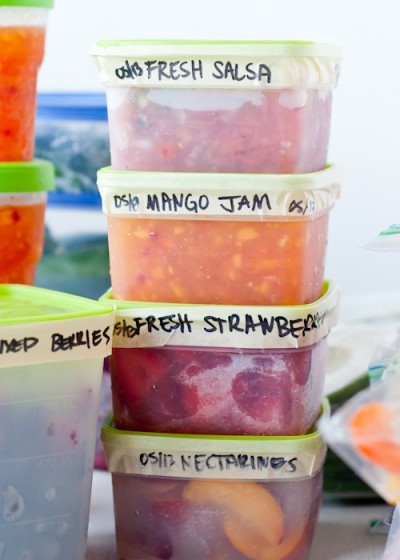We all want that fresh tasting summer fruits and vegetables but most people can’t achieve when they go to freeze their fruits and vegetables. Well, do not worry anymore we found an article over Mom Design that makes it super easy and assures you to keep the most amount of nutrients and the most amount of freshness you can get when freezing. Let us know how you do!
When I was a little girl, I loved going to my Grandma Maxie’s house. There was always something yummy to eat, especially during the summer when her garden was brimming with strawberries, rhubarb, peaches, and all sorts of veggies. I used to pass by the giant (ancient) freezer on my way through the garage to the backyard and I would stop, open it, and gaze at the stacks and stacks of square freezer containers with green or yellow lids. Each had tape around it and was labeled with the contents. My favorite, no surprise, was her strawberry and raspberry freezer jam.
A big plus for freezing produce is that it ends up tasting much fresher and contains more nutrients than canned produce.But there is a draw back as well. The texture of thawed veggies and fruit can be undesirable. In the process of freezing, the water within the fruits and veggies turns to ice. As it does, it expands which causes cell walls to burst. This can equal mushy texture when thawed.
But there are steps you can take to ensure higher quality frozen fruits and veggies — similar to the ones you buy at the grocery store. And we’ll cover those below.
First let’s talk about the materials you’ll need to assemble before you start.
Secret #1: Something great thing about freezing fruits and vegetables is that you don’t really need fancy equipment. Freezer bags come in handy for “dry pack” freezing that doesn’t involve using syrups or purees. Rigid plastic (and sometimes glass) containers and jars come in handy for liquid or semi-solid foods, sauces, jams, and other preserves.
I stocked up on both sorts of containers (including some pretty awesome jars for freezer jam) and plastic freezer bags at Target.
In addition to containers, I also recommend freezer paper, freezer tape, and heavy-duty foil. They come in handy for packaging certain foods and for long-termstorage. Long term means longer than the typical 6-12 months. The longer you store the food in the freezer, the more the quality declines, but it is still perfectly fine to eat.
Another essential for me is a rimmed baking sheet. I use it to quickly freeze individual pieces of whole or sliced produce. More on that in a bit.
Again, I found all the materials I needed for this post — from bowls, to markers, to baking sheets — at Target.
PREPARE THE FOOD
You’ll want to wash all fruits and vegetables well, especially if you don’t plan on peeling them, and pat them dry with a paper towel or dishtowel. Some fruits and vegetables can be frozen whole, while others need to be peeled, pitted, and/or cut into smaller pieces. A bit of it is personal preference, but some produce definitely does better in the freezer when cut into smaller pieces.
Secret #2: Fruits and veggies that do exceptionally well frozen whole:
Berries (raspberries, strawberries, blueberries, blackberries, currants, cranberries, etc.), bananas, chili peppers, beans, asparagus, tomatoes, and corn.Secret #3: Produce that does well sliced or diced:
Bell peppers, avocado, mango, pineapple, melon, peas, carrots, broccoli, cauliflower, stone fruits (peaches, nectarines, plums, cherries), apples (yes, you can freeze apples!), summer squash, and winter squash.Cut broccoli and cauliflower into florets. Shell peas, trim the ends of green beans and asparagus. Dice or slice peeled carrots, squash, brussels sprouts, and largeleaves of spinach, chard, and kale. Rhubarb should be trimmed of woody ends and diced.
Potatoes can be frozen, but benefit from being shredded. Think: hashbrowns. (Note: I personally don’t like freezing potatoes at home. The quality just isn’t as good.) Zucchini is another veggie with a high water content. It can be sliced or diced and frozen, but I prefer shredding it instead.
Corn and bananas are pretty versatile when it comes to freezing. Corn can be frozen whole or cut from the cob. It’s totally up to you! I think it’s one of the best veggies for freezing because the quality isn’t as affected by the cold temperatures.
Bananas can be frozen whole and unpeeled, or peeled and whole, or peeled and cut. They’re pretty fabulous that way! I can’t resist adding a frozen banana to my daily smoothie to sweeten it up without adding sugar.
After fruits and veggies have been peeled, sliced and diced, as needed, there are a few more preparation steps.
Secret #4: Most vegetables also need to be blanched before freezing. Blanching is nothing more than plunging vegetables into a pot of boiling water, letting them cook briefly (3-4 minutes max), and transferring them to a big bowl of ice water to stop the cooking.
Why is this important? Remember that mushiness I mentioned earlier? This will help with that, but it also helps maintain the color and nutrients, as well as killing any surface organisms that could lead to spoilage.
Corn (though you could), tomatoes, onions, potatoes (including sweet), and winter squash don’t need to be blanched. And neither do fruits.
Leafy greens don’t have to be cooked, but they can be. But one thing is for sure, quickly sauteing spinach, for instance, really saves on space! Pictured above is four ounces of spinach cooked and fresh.
Something I saw a few months ago (and a few of you lovely readers mentioned to me) that I think is brilliant, is making spinach ice cubes to add to smoothies. I usually just put the greens into my smoothie packs, but I finally tried this and I’m hooked! Simply add a whole bunch of leafy greens to a blender with enough water to make a smooth puree and freeze. Easy peasy!
I also like to roast some foods before I freeze them. I’ve done this with tomatillos, plums, tomatoes, and peppers. I will either puree them into a sauce or freeze them as is, juices and all.
Secret #5: In canning, foods are treated with citric acid, lemon juice, or ascorbicacid to help kill microorganisms and prevent discoloration. The same rings true with freezing. Think of all of your favorite fruits that turn brown after being cut — bananas, avocado, peaches and nectarines, apples, etc. They benefit from a quick dip into acidulated water.
Make a solution of 1/2 teaspoon ascorbic acid (found in the pharmacy or canning section of grocery stores) per 3 Tablespoons of water, or 1 Tablespoon fresh lemon juice in 4 cups (1 quart) water. Sprinkle or dip the fruit with the solution and let dry.
FREEZING
First up, Dry Pack freezing, where we start by talking about IQF, or Individually Quick Frozen. The idea behind this is simple: if a fruit/veggie is frozen in a single layer (whole or sliced), it will freeze more quickly.
Secret #6: Freezing quickly is great because a) fruits and veggies are easy to thaw out if they aren’t frozen together in a big lump, and b) the quality is better after thawing.
All you do is place everything you want to freeze in a single layer on a lined baking sheet. Lined, so that what you’re freezing doesn’t stick to the pan.
The goal is to freeze the food as quickly as possible. Adjusting the temperature of the freezer ahead of time is a good idea. You want to ensure that it’s as cold as possible — at least 0 degrees F or lower. You also want to make sure there is plenty of air circulation for even freezing, so it’s better not to layer a bunch of bags or containers in the freezer at once. Doing it over the course of a day or a few daysis a good idea.
Be sure to not open the freezer as the produce is freezing on the baking sheets. You really want them to freeze as quickly as possible without fluctuating temperatures. When the food is frozen, transfer to containers or bags and place the bags back in the freezer.
Removing air from containers and bags will help keep frozen food last that much longer and help prevent hoar frost from forming.
Read Full Article: Living Well: 11 Secrets To Properly Freezing Produce







The Ultrasound Solution
Apr 12. 2016
posts like this are why I love facebook